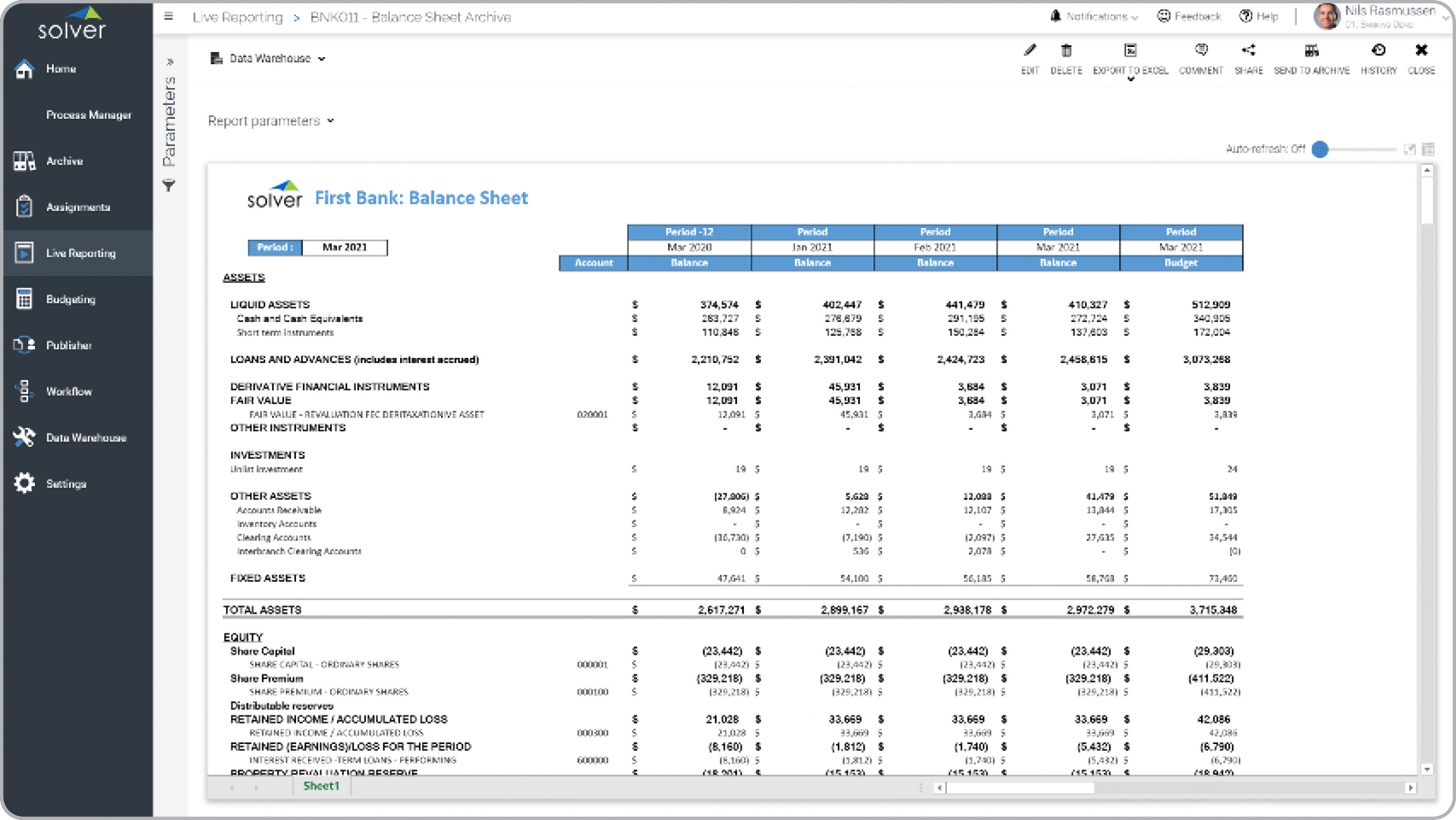Trended Balance Sheet Report for Banks
What is
a
Trended Balance Sheet Report for Banks
? Trended Balance Sheets are considered analytical financial reports and are used by executives and CFOs to track monthly trends in assets, liabilities and equity. Some of the main functionality in this type of report is that it dynamically expands months across the columns based on the period you run the report for. The rows in the reports show a typical balance sheet layout with Assets, Liabilities and Equity sections and account balance details rolling up to sub-totals. The user can get further detail by drilling down on individual cells to see transaction-level information. You find an example of this type of report below.
Purpose of
Trended Balance Sheet Reports Banks use Trended Balance Sheet Reports to give executives both detailed and summarized views of assets and liabilities for each month up to the current period. When used as part of good business practices in Executive- and Financial Planning & Analysis (FP&A) departments, a bank can improve its strategies and profitability, and it can reduce the chances that leaders make poor decisions because they don't see if a figure is a trend or an outlier.
Example of a
Trended Balance Sheet Report Here is an example of Trended Balance Sheet Report with dynamic listing of year-to-date months and rows that can expand/collapse to simplify analysis. [caption id="" align="alignnone" width="2560"]
 Example of a Trended Balance Sheet Report for Banks[/caption] You can find hundreds of additional examples
here
Who Uses This Type of
Report
? The typical users of this type of report are: Executives, Regional Managers, Branch Managers, CFOs, Analysts.
Other Reports Often Used in Conjunction with
Trended Balance Sheet Reports Progressive Executive- and Financial Planning & Analysis (FP&A) departments sometimes use several different Balance Sheet Reports, along with income statement variance and trend reports, cash flow statements, financial dashboards, KPI dashboards, budget models and other management and control tools.
Where Does the Data for Analysis Originate From? The Actual (historical transactions) data typically comes from enterprise resource planning (ERP) systems like: Microsoft Dynamics 365 (D365) Finance, Microsoft Dynamics 365 Business Central (D365 BC), Microsoft Dynamics AX, Microsoft Dynamics NAV, Microsoft Dynamics GP, Microsoft Dynamics SL, Sage Intacct, Sage 100, Sage 300, Sage 500, Sage X3, SAP Business One, SAP ByDesign, Acumatica, Netsuite and others. In analyses where budgets or forecasts are used, the planning data most often originates from in-house Excel spreadsheet models or from professional corporate performance management (CPM/EPM) solutions.
What Tools are Typically used for Reporting, Planning and Dashboards? Examples of business software used with the data and ERPs mentioned above are:
Example of a Trended Balance Sheet Report for Banks[/caption] You can find hundreds of additional examples
here
Who Uses This Type of
Report
? The typical users of this type of report are: Executives, Regional Managers, Branch Managers, CFOs, Analysts.
Other Reports Often Used in Conjunction with
Trended Balance Sheet Reports Progressive Executive- and Financial Planning & Analysis (FP&A) departments sometimes use several different Balance Sheet Reports, along with income statement variance and trend reports, cash flow statements, financial dashboards, KPI dashboards, budget models and other management and control tools.
Where Does the Data for Analysis Originate From? The Actual (historical transactions) data typically comes from enterprise resource planning (ERP) systems like: Microsoft Dynamics 365 (D365) Finance, Microsoft Dynamics 365 Business Central (D365 BC), Microsoft Dynamics AX, Microsoft Dynamics NAV, Microsoft Dynamics GP, Microsoft Dynamics SL, Sage Intacct, Sage 100, Sage 300, Sage 500, Sage X3, SAP Business One, SAP ByDesign, Acumatica, Netsuite and others. In analyses where budgets or forecasts are used, the planning data most often originates from in-house Excel spreadsheet models or from professional corporate performance management (CPM/EPM) solutions.
What Tools are Typically used for Reporting, Planning and Dashboards? Examples of business software used with the data and ERPs mentioned above are:
- Native ERP report writers and query tools
- Spreadsheets (for example Microsoft Excel)
- Corporate Performance Management (CPM) tools (for example Solver)
- Dashboards (for example Microsoft Power BI and Tableau)
Corporate Performance Management (CPM) Cloud Solutions and More Examples
September 7, 2021
TAGS:
Reporting,
Solver,
report writer,
Microsoft,
template,
practice,
Acumatica,
financial statement,
Netsuite,
Finance,
planning,
GP,
fintech,
Business Central,
excel,
ax,
forecast,
Budget,
Dynamics 365,
analysis,
budgeting,
KPI,
bank,
Cloud,
Software,
Tableau,
SAP,
example,
best,
Sage,
BC,
D365,
NAV,
Intacct,
monthly,
financial institution,
Balance Sheet,
CPM,
report,
branch,
SL,
Management,
dynamics,
Power BI,
financial report

